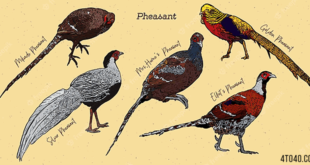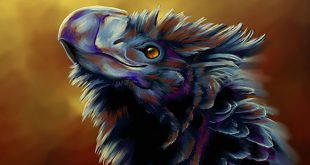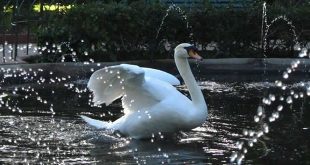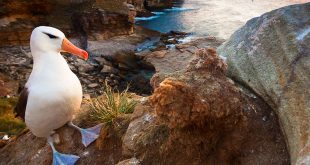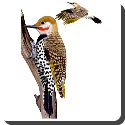 Flicker — The Flicker (Colaptes auratus) is a medium-sized member of the woodpecker family. It is native to most of North America, parts of Central America, is one of the few woodpecker species that migrates, and is the only woodpecker that commonly feeds on the ground.
Flicker — The Flicker (Colaptes auratus) is a medium-sized member of the woodpecker family. It is native to most of North America, parts of Central America, is one of the few woodpecker species that migrates, and is the only woodpecker that commonly feeds on the ground.
Adults are brown with black bars on the back and wings and measure approximately 32 cm (12.5 inches) in length. A necklace-like black patch occupies the upper breast, while the lower breast and belly are beige with black spots. Males can be identified by a black or red moustachial stripe at the base of the beak. The tail is dark on top, transitioning to a white rump which is conspicuous in flight.
There are two forms which were formerly considered separate species:
The Yellow-shafted Flicker resides in eastern North America. They are yellow under the tail and underwings and have yellow shafts on their primaries. They have a grey cap, a beige face and a red bar at the nape of their neck. Males have a black moustache.
The Red-shafted Flicker resides in western North America. They are red under the tail and underwings and have red shafts on their primaries. They have a beige cap and a grey face. Males have a red moustache.
These two forms interbreed where their ranges overlap.
Their breeding habitat is forested areas across North America, as far south as Central America. They nest in a cavity in a tree or post; this bird excavates its own home. Abandoned flicker nests create habitat for other cavity nesters. They are sometimes driven from nesting sites by European Starlings.
It takes about 1 to 2 weeks to build the nest which is built by both sexes of the mating pairs. Damaged nests or previously abandoned cavities may be repaired. The entrance hole is roughly 5 cm to 10 cm wide. Flickers will sometimes be willing to use a birdhouse if it is adequately sized and properly situated.
Typically 6 to 8 eggs are laid, having a shell that is pure white with a smooth surface and high gloss. The eggs are the second largest of the North American woodpecker species, exceeded only by the Pileated Woodpecker’s. Incubation is by both sexes for approximately 11 to 12 days. The young are fed by regurgitation and leave the nest about 25 to 28 days after hatching.
Northern birds migrate to the southern parts of the range; southern birds are often permanent residents.
According to the Audubon guide, “flickers are the only woodpeckers that frequently feed on the ground”, probing with their bill, also sometimes catching insects in flight. Although they eat fruits, berries, seeds and nuts, their primary food is insects. Ants alone can make up 45% of their diet. They have a behavior called anting, during which they use the acid from the ants to assist in preening, as it is useful in keeping them free of parasites.
 Kids Portal For Parents India Kids Network
Kids Portal For Parents India Kids Network
